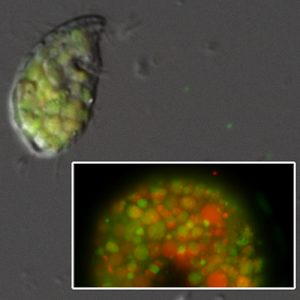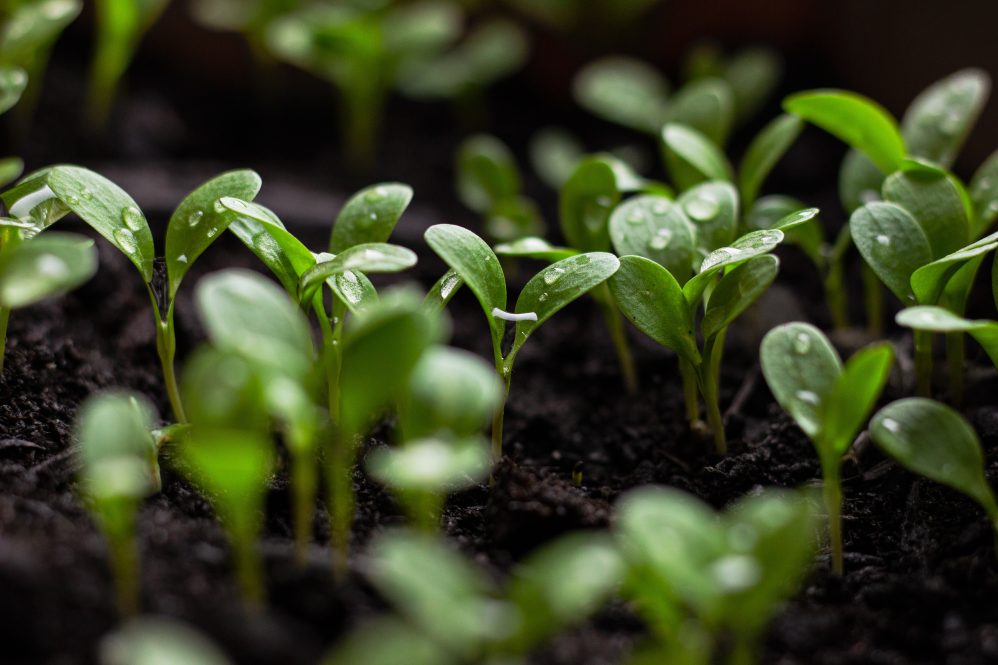Protists, a broad class of generally single-celled organisms that includes algae and amoebae, have long been regarded as a “catch-all” category for diverse microorganisms. Because of their diversity and prevalence, protists play vital roles in virtually every ecosystem on earth. But until recently, one of those roles was poorly understood.
New research led by UConn’s Chris Hawxhurst, Leslie M. Shor, and Daniel Gage has illuminated one way protists support the growth of plants: by ferrying helpful, nitrogen-fixing bacteria deep into their root systems. The team recently published their findings in the journal Applied and Environmental Microbiology.
“That ‘moms in minivans moving the kids from place to place’ concept is not something that was really demonstrated before,” says Shor, the associate dean for Research and Graduate Education in the School of Engineering. Her research has focused on soil ecosystems for years, a field she calls “wonderfully complex.”
This specific project began to germinate nearly a decade ago. Shor and Gage, the associate head of Undergraduate Research and Education in the Department of Molecular and Cell Biology, received a Bill & Melinda Gates Foundation seed grant in 2014 to explore the ability of protists to move beneficial bacteria around roots.
“That was the first time we got funding to look at the potential for using protists to intentionally mix or relocate bacteria or other things in the subsurface [of soil],” Shor says. “That gave us our first chance to look into this in more detail – before then, it was just a crazy idea.”
Chemical engineering Ph.D. student Chris Hawxhurst joined the project in 2018. The researchers’ interdepartmental collaboration offered some creative solutions to the challenges of visualizing the motion of microorganisms within soil.

Gage’s lab, focused on biology, provided the live materials for the experiment. Jamie Micciulla, then a cellular and molecular biology Ph.D. student working in the lab, grew the plants; Charles Bridges, a postdoctoral researcher, engineered the bacteria to glow red so it could be visually tracked. Gage isolated the protists from his own backyard.
Hawxhurst and the Shor lab provided engineering expertise, creating devices that enabled the team to observe the transport of the bacteria along growing roots in a real soil system, as well as the computer program needed to process thousands of individual digital photomicrographs into meaningful spatial data.
The researchers found that the presence of protists significantly expanded the reach of beneficial bacteria along the root systems of the Medicago truncatula (also known as the barrelclover) plant. Their discovery of this effect paves the way for future experiments to demonstrate the reliability of protists in an agricultural setting, like a soybean field.
“Soybeans are a major crop, and they rely on the same type of symbiont we used; the plants are also closely related to Medicago,” Gage says. “So, one of the key plants out there that might use this technology would be something very closely related to what we’re already studying.”
Agricultural seeds are often inoculated with beneficial bacteria intended to aid growth and resilience of the plant. The researchers believe that augmenting this inoculation with protist cysts – the shelf-stable resting stage of protists – could boost the efficacy of the added bacteria by ensuring they reach where the plant needs them most.
“Those beneficial bacteria added to seeds may never leave the area where they’re planted in the field – they sort of stick there. That’s a huge, huge problem,” Gage explains. “And this really green technology – there are no pathogens, there’s no recombinant DNA, it’s all just straight-up soil biology – if something like this came along that would allow seed companies’ products to be more effective and would boost production and profit for farmers, then I think the market could be really big.”
Shor is also optimistic about how protists could help facilitate a worldwide move to more sustainable agriculture.
If something like this came along that would allow seed companies’ products to be more effective and would boost production and profit for farmers, the market could be really big.
“We’re learning that no-till farming practices, where the soil isn’t stirred up with a combine every year, are much more sustainable,” she says. “It allows the soil to hang on to a lot more carbon, and less of that soil carbon is converted into CO2 and ends up in the atmosphere. But in order for no-till farming to work, you’ve got to be able to move stuff through the soil and reach the plant roots. And so, this protist-facilitated transport technology may also enable sustainability by helping you get stuff – beneficial bacteria, and anything else you’re applying at the surface to help a plant grow – to where it needs to go.”
Gage and Shor are a true example of an innovative team: a microbiologist and engineer working together to better understand how structure imparts function in soil systems. They worked with UConn’s Technology Commercialization Services (TCS) to protect the intellectual property associated with their technology, which is now patented.
Ana Fidantsef, an Industry Liaison at TCS and a plant biologist herself, is very excited about the potential of this technology and anticipates significant interest from the industry.
“Soil microbiomes are a trending topic right now,” Fidantsef says, “and our patents can definitely not only shed light on this wonderful system that we cannot see but can also take advantage of its complex richness to further help us feeding the world.”



